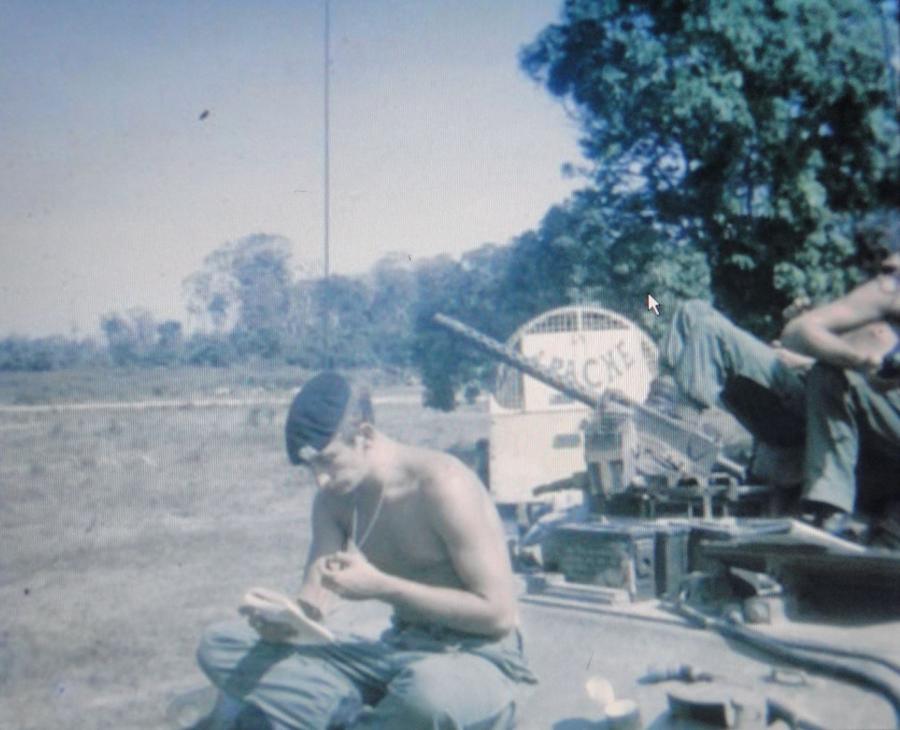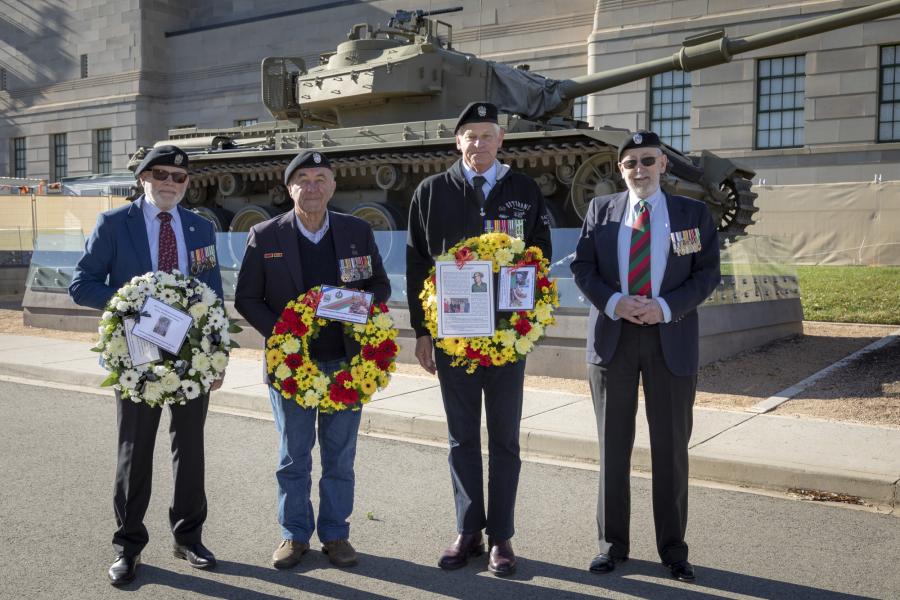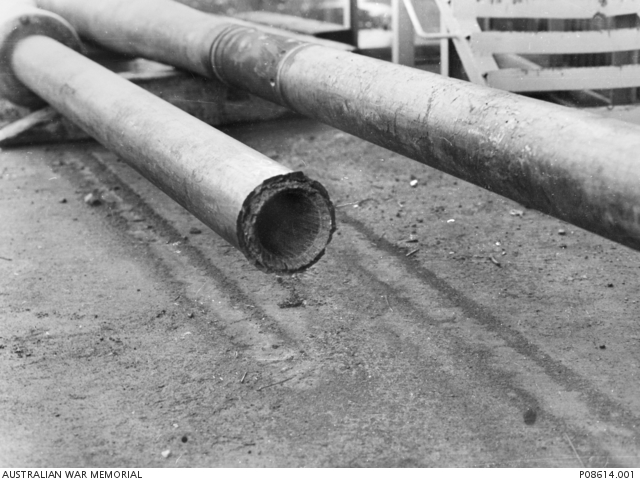'I knew there was a fair chance I would be killed, but I thought it was the right thing to do'

Lieutenant Colonel Bruce Cameron MC in Vietnam. Photo: Courtesy Bruce Cameron
Bruce Cameron was 22 years old when he climbed out of his Centurion tank and risked his life to save a soldier who had been severely wounded and was in danger of being killed.
“Before I got out of the turret,” Bruce said, “I counted down – three, two, one, go – and I said to myself, I’ll either get killed, or I’ll get an MC, but I didn’t know that was literally true.”
It was 25 June 1971, and Lieutenant Colonel Bruce Cameron MC was a young Second Lieutenant, serving as a troop commander with C Squadron, 1st Armoured Regiment in Vietnam.
His tank had been hit by a rocket propelled grenade during an assault on an enemy bunker system as part of Operation Hermit Park, a joint infantry/armoured clearance operation conducted in thick, dense jungle near the De Courtenay Rubber Plantation in Phuoc Tuy Province.
“We started out for Hermit Park with six tanks and ended up with two,” he said.
“My first tank broke down, and then I had to go and take over 5 Bravo [from Lance Corporal Tony Dickinson].
“Then a tree branch fell, and landed on top of my driver [Trooper Terry Jones]. That knocked him unconscious … so another driver came forward, and that driver was Peter Cadge.
“Then [Corporal] Andy Anderson’s tank was hit and essentially knocked out … with the crew badly wounded.
“We were then down to three tanks. And that’s when my tank – 5 Bravo – was hit by an RPG, and Peter Cadge was badly wounded.”
The burnt canvas mantlet cover of Centurion 5B after it was hit by an RPG on the barrel, just above the driver's compartment, during Operation Hermit Park on 25 June 1971.
The RPG round struck the main gun barrel on the lower right side, sending splash fragments flying. Trooper Peter Cadge, suffered severe head injuries and was attempting to climb out of the driver’s compartment. Without any thought for his own safety, Bruce climbed out of the turret and, in full view of the enemy bunkers, went to his driver’s aid.
“The tank was hit, and Peter Cadge was badly wounded,” Bruce said.
“He had this shrapnel wound to the top of his head, and quite considerable injuries.
“The RPG had hit the bottom of the barrel directly above his driver’s compartment, and the tank just stopped.
“We didn’t know Peter had been hit at this stage. But then we heard him, and we knew he’d been wounded.
“We tried to get to him from inside the tank, which you can do. You can move into the driver’s compartment from the turret, but the tank’s gun has got to be in a certain direction relative to the hull for you to be able to do it.
“We couldn’t traverse the turret because there were two trees on either side of the tank, and we couldn’t engage the area where I thought the fire was coming from, so I had to get the tank on our right to to suppress the enemy.
“I was firing the commander’s machine gun at this stage, and our gunner [Trooper Kim Bayly] saw Peter trying to get out of the driver’s seat and told me to stop firing.
“The driver of the tank on our left could also see Peter trying to raise himself up from the driver’s compartment, but we couldn’t get to him, so I had to get out, and I had to get out quickly.”
The RPG round struck the main gun barrel on the lower right side. The driver Trooper Peter Cadge, was badly wounded. Trooper Cadge was Mentioned in Despatches for his bravery in going to the aid of the rest of his crew, despite his own severe wounds. His headphones are hanging on the driver’s vision block of the open hatch.
Ordering his crew to continue firing, Bruce launched himself up and out of the turret, and scrambled down onto the ground to help Peter, in full view of the enemy, armed with nothing more than a 9 mm automatic pistol.
“I soon realised it was no use – a pistol is hopeless,” he said. “What I needed was a substantial semi-automatic weapon, not a pistol. I had to put it away because I had to use both hands to break my way through the vegetation to get to the front of the tank and get to Peter.
“He said to me, ‘Oh, thank goodness you’re okay,’ because despite his wound he was trying to come to our rescue.
“The RPG had set fire to the canvas cover on the front of the turret, and it was burning, so Peter thought the tank was on fire, and he was coming to our aid, to check on us.”
Bruce knew they didn’t have much time. The enemy was attempting to outflank the attacking vehicles and it was soon apparent that the assaulting force had run into what was a well-prepared, newly constructed bunker system.
“I knew there was a fair chance I would be killed, but I thought it was the right thing to do,” Bruce said.
“It was just instinct. The first duty of the troop leader is to safeguard his troop, and you’re too busy to be frightened …
“It was a deliberate act – it wasn’t a spontaneous thing – because I had to make sure the other tanks weren’t going to be in danger.
“In training, you are taught to save your ammunition and make sure you can see the target, but in the jungle, you have to dominate by fire. That means you might not be able to see the enemy, but you’ve still got to engage that area to establish your fire superiority and to prevent them from engaging you …
“We couldn’t be sure, unless we were able to dominate the ground in front of us, that the enemy wouldn’t be capable of further engagement. So I had to make sure the other tanks dominated the ground by fire, then get out and get to Peter to get him to safety …
“You’re so focused on what you’re doing. I wasn’t concerned about what the enemy were doing at that stage. I was only focused on getting to Peter and getting him down from the front of the tank and back to safety.”
Sergeant Stan Hanuszewicz was awarded the South Vietnamese Gallantry Cross with Bronze Star for his actions during Operation Hermit Park.
Corporal ‘Stan’ Hanuszewicz was the crew commander of the tank on Bruce’s right flank. He watched on from about 15 metres away. Within minutes, his tank was hit by several RPGs, wounding him in the face and neck.
“He could see me at the front of the tank at the same time as the enemy fired another RPG at us,” Bruce said.
“It would have done a lot of damage if it had hit us, but it struck the muzzle of his barrel, and bent it to the left.
“He looked down the bore, and he had sufficient presence of mind to load a solid shot round and fire the end of the barrel off so that he could then keep engaging the enemy, and that was just an incredibly smart thing to do.
“We reported that the barrel was bent, and the bore was blocked, and the engineers said: ‘Don’t fire! Tell him not to fire!’ But it was too late. He’d already fired, and shot it off, and he was able to keep engaging.
“He received a couple of other RPGs as well, but he was able to dominate by fire, which meant the enemy ended up withdrawing, and so it all turned out, not okay, but better than it would have.
“I told Peter we’d get him ‘dusted off’ as quickly as possible, emphasising that he had to get back into the driver’s compartment for his own safety.
“The proximity of the enemy meant there was no possibility of him being extracted and taken to the rear at that moment.
Stan Hanuszewicz's tank, the barrel of which, which was damaged during Operation Hermit Park.
“I was then able to get back into the turret to control the fire of the other tanks.
“At this stage, the tank on my right saw the enemy withdrawing. This allowed another officer to come forward so that, together, we were able to help Peter to the rear.
“While this was happening, our gunner [Trooper Kim Bayly] was looking through the gunner’s sight and saw enemy in the bunker.
“The main gun barrel had been hit by this RPG when Peter was wounded, and it penetrated the wall, but as far as we could tell, it hadn’t gone right through.
“By this time, a replacement driver [Troop Bernie Weston] had come forward and he was directed to adjust the tank’s position.
“Our gunner then got the operator [Trooper “Bo” Janic] to load a round and they were able to engage the bunker while I was out of the turret …
“By this stage, the position had been taken, the enemy had withdrawn, and we were in command of the position, but the loss of surprise meant that it came at an enormous cost.
“Capturing these bunkers pales into insignificance with the losses that we had taken. And all of this was because we had no surprise.
“We’d started out attacking an enemy position, but it wasn’t where it was supposed to be, so the attack went on, and went on, and went on, and the enemy knew that we were coming and what was happening.
“They had all the time in the world to gather together their stores and prepare their forward defences and gather anti-tank weapons together where they would be needed.
“We were effectively down to two tanks at the end, and all of this, because we had no surprise.
“The success of armoured operations is really predicated on shock action and surprise, and we just didn’t have it on that occasion.”
Bruce was awarded the Military Cross for his actions in Vietnam and went on to write a two-volume box set, Canister! On! FIRE!: Australian Tank Operations in Vietnam, in recognition of the bravery of the tank crews who served there.
Today, the tank he commanded at Hermit Park – 5 Bravo – is on display outside the Australian War Memorial in Canberra. The damaged gun barrel from the tank Stan Hanuszewicz commanded is on display in the Vietnam Galleries.
For the men who were there that day, it’s particularly poignant.
Bruce and Stan was reunited with the gunner, Kim Bayly, and the tank’s original commander, Tony Dickinson, at the Memorial for the 50th anniversary. Wreaths were laid in honour of Corporal Andy Anderson and Trooper Phillip Barwick, who were severely wounded at Hermit Park and later died as a result of their war service. Peter Cadge and Bo Janic were unable to attend due to a COVID-19 lock-down.
The men presented Bruce with a special plaque in front of the tank, which reads: “To Lieutenant Colonel Bruce Cameron MC … A man of leadership, compassion and courage for his troops.”
Bruce was moved beyond words.
“The tank in action is not a piece of engineering, it is the beating heart of its crew,” he said.
“And, in terms of the tanks, the crew is the crew, both in word, and in deed; you’re relying on each other.

Bruce Cameron MC, far right, with Tony Dickinson, Stan Hanuszewicz and Kim Bayly in front of the Centurion tank 5 Bravo at the Memorial.
“A tank is more than just an armoured vehicle. It is the crew who bring its guns to bear, and it is their spirit and determination to achieve fire superiority at the point of battle, despite the risks, that is at the heart of armoured warfare.
“It’s good to have [5 Bravo] on display at the Memorial, as a focus for the crew, and for others who operated tanks in Vietnam, who see it as a symbol of events 50 years ago. But it’s also good as a basis for telling stories, and for explaining to people what it was like for the tank crews in Vietnam.
“The tanks were constantly on call, so you could never really relax … and it wasn’t just one incident, it was every day.
“You had to have complete confidence in each other and cooperate instinctively … and that’s what we did.
“You don’t like to dwell on things that otherwise might be a bit upsetting, but it’s the bravery of the guys, and the difference that they made, and the difference that tank firepower made, that’s the story that needs to be told.”







